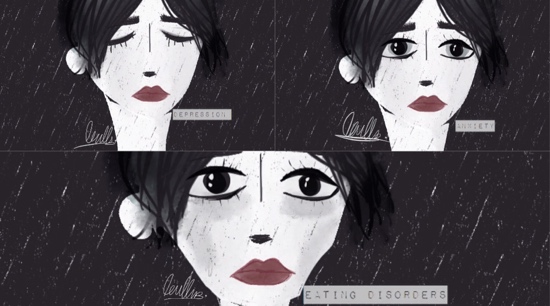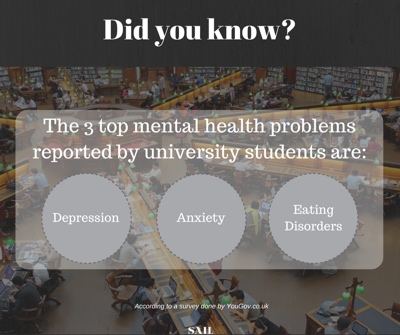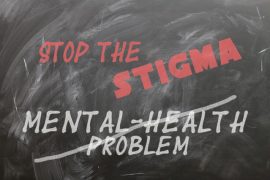Research has shown that the top 3 mental health problems suffered by university students are depression, anxiety disorders, and eating disorders. But what do those health problems really mean and what are their most known symptoms?

The statistics on mental health among the youth are alarming, to say the least. One statistic shows that one in every four university students suffers from a mental health problem. Another statistic shows that the top three mental health problems among university students are depression, anxiety disorders, and eating disorders[1]. Many of us now know that mental health is more than the traditional extreme diagnosis of schizophrenia, paranoia, or bi-polar. We’re also realizing that depression, anxiety, eating disorders, substance abuse, self-harm and so much more are all considered to be problems under the mental health.
Now more than ever it is becoming crucial to learn about mental health problems, particularly for the youth. On the one side, it’s because youth are more prone to these problems than other age groups[2], and so learning about them can enable them to recognize it sooner and empower them to deal with it better. On the other side, understanding the problems and how to spot them can be instrumental in helping family and friends who might be going through them. Peer help and support can play a huge role in coping with mental health problems[3] [4].
According to the National Alliance on Mental Illness, mental health problems or mental illnesses are:
“Medical conditions that disrupt a person’s thinking, feeling, mood, ability to relate to others and daily functioning. Just as diabetes is a disorder of the pancreas, mental illnesses are medical conditions that often result in a diminished capacity for coping with the ordinary demands of life.”[5]

As the top 3 mental health problems among university students are depression, anxiety disorders, and eating disorders; we’ll explain below what each of those means in general terms, and what some of the symptoms can be.
Depression
Depression is the number one mental health problem suffered by the youth and the majority of the population of all age groups. Though the word “depressed” has been abused and desensitized by some, it’s still very important to pay attention when it’s said, and it must be scrutinized because it could be a cry for help. According to Mayo Clinic, depression among the youth is, “a serious mental health problem that causes a persistent feeling of sadness and loss of interest in activities. It affects how one thinks, feels and behaves, and it can cause emotional, functional, and physical problems. Although depression can occur at any time in life, symptoms may be different between teens and adults.”[6] It is worth noting that for the depression to be diagnosed, those feelings that affect your day-to-day life should persist for at least 2 weeks[7].
Some of the common symptoms of depression are[8] [9] [10]:
- Poor performance in school and drop in grades.
- Irritable mood and easily agitated on small remarks and incidents.
- Persistent low, sad or depressed mood to an extent of being unable to cope with daily activities.
- Loss of interest and pleasure in usual activities.
- Change in sleeping patterns. Most commonly reduced sleep, with difficulty getting to sleep, disturbed sleep, and/or waking early and being unable to go back to sleep.
- Change in appetite. Most often people do not feel like eating. Some people have increased appetite, often without pleasure in eating.
- Decreased energy, tiredness and fatigue. These feelings may be so severe that even the smallest task seems too difficult to finish.
- Frequent complaints of unexplained body aches and headaches.
- Social isolation and withdrawal from friends and activities.
- Irresponsible behavior – for example, forgetting obligations, being late for classes, skipping school.
There are many more symptoms and behaviors that are common in people suffering depression[11]. It’s important to understand that different people present the symptoms differently.
Anxiety Disorder
This type of mental health problem can be very tricky to self-diagnose at times, for two reasons. First, often people don’t even know that this is a real mental health condition, they can’t deal with what they don’t even know exist. Second, most of those who suffer from it think their symptoms are the natural reaction to a situation they go through, especially due to the fact that those symptoms are almost always internal, so there is no visible comparison they can make against others’ reactions to the same situations.
So, what is anxiety disorder? While being anxious and worried are generally natural reactions to stressful situations, as biologically these feelings will drive us to perform in those situations or at least to be alert to them, however, having anxiety disorder leads these feelings of anxiousness and worry to be exaggerated and to be overwhelming and crippling to the extent they stop you from being able to live your day-to-day life in a healthy manner. In addition to that, having this type of disorder can lead to having anxiety (or panic) attacks regularly, with or without triggers[12] [13]. Some explained the feelings they get during an attack as, “a swarm of bees just buzzing buzzing buzzing, not stopping, making it impossible to focus and seemingly impossible to slow down and take a breath.”[14] Others say anxiety feels like “your mind is on fire, overthinking and over analyzing every little, irrelevant thing… It feels as if your thoughts are running wild in a million different directions, bumping into each other along the way… Anxiety feels like there is a voice in the back of your mind telling you that everything is not okay, when everything in fact is.”[15]
These attacks can be caused by the genetic compositions of a person, part of the brain’s biochemical composition of a person, or as an environmental result[16]. University students who suffer from anxiety disorders can notice a rise in the number of anxiety attacks they are having during exam periods and assignment submission periods.
Some of the common symptoms of anxiety disorder are:
- Persistent anxious thoughts about everyday things, large and small[17].
- Persistent self-doubt and second-guessing.
- Exaggerated panic, fear, and uneasiness.
- Not being able to stay calm and feeling tense or jumpy.
- Heart palpitations and feeling the heart is pounding and racing.
- Dry mouth, sweating, tremors, and twitches.
- Nausea, upset stomach, vomit, frequent urination or diarrhea.
- Headaches, muscle tension, fatigue, and insomnia.
It’s important to know that there are different types of anxiety disorders: Panic Disorder in which the attack would be a result of a situational trigger, Social Anxiety Disorder which would be triggered by being in a social setting, and Generalized Anxiety Disorder in which the attacks could happen often without a reason. There are more types as well to be explored when looking to learn more about this condition.
Eating Disorders
Eating disorders are often dismissed by parents with assumptions that the youth are being spoiled, just want to lose weight, picky in eating, or in the case of binge eating, dismissed as healthy appetite or being thick-boned. When the eating disorders start to manifest negatively on the youth’s health, parents often get angry thinking it’s a conscious behavior to eat or not to eat and will try to force them into eating (or not eating in the case of binge eating). However, what’s important to understand is that this type of disorder isn’t a chosen diet or a lifestyle, and it certainly isn’t a conscious behavior by the person suffering from it[18]. It is often an unconscious behavior, or in some cases a mental obsession with the body image and weight[19], and in some cases, it has to do with the person’s feelings and the way they cope with those feelings.
Eating disorders are broken into 3 main categories: Anorexia, Bulimia, and Binge-Eating Disorder. Anorexia is when the person is unconsciously obsessed with their weight, and keep feeling they are “fat”, and constantly checks their weight. Accordingly, they eat the bare minimum and obsessively calculate the calories of everything they ingest to ensure they don’t add a single gram. Bulimia is when a person has regular episodes of overeating without control, and then soon afterward will attempt to purge that food out of their bodies whether through vomiting, extreme long exercises, or using laxatives to cause diarrhea. Binge-eating is similar to Bulimia in the sense that it involves regular episodes of uncontrolled eating, but in this case, it isn’t followed by any attempts to purge what was eaten, and often the result is obesity. All three categories of this disorder can be detrimental and individuals can’t be managed by themselves. They often require medical help and attention, and a regular management approach to keep the person suffering from it on track, as relapse is very common.
A movie was produced by Netflix in the year 2017 called “To The Bone.” It was a story about a group of young adults who entered an eating disorder therapy facility, with a character or two from every eating disorder. It followed their journey of the therapy program, along with what they felt and how their disorders manifested. It’s a great movie for those who never understood this type of mental health problem and are looking to learn about it and humanize it.
These three mental disorders: depression, anxiety, and eating disorder, are the top mental health problems faced by the youth. Knowing more about them is essential for the youth and for the older generations, to be able to recognize if they are suffering from one, and to educate the people around the ones suffering, to extend a better support and understanding.
This article has been written as part of The UAE Rosalynn Carter Fellowship for Mental Health Journalism sponsored by Al Jalila Foundation.
P.S. If you’re facing any sort of mental health issue problems, please refer to this post for suggestions on how to get help.
References:
[1] https://yougov.co.uk/news/2016/08/09/quarter-britains-students-are-afflicted-mental-hea/
[2] https://sailemagazine.com/2018/04/the-case-of-mental-health-among-university-students-and-the-potential-triggers/
[3] https://www.mentalhealth.org.uk/a-to-z/p/peer-support
[4] https://www.iriss.org.uk/resources/insights/peer-support-roles-mental-health-services
[5] https://namica.org/resources/mental-illness/mental-illness-facts/
[6] https://www.mayoclinic.org/diseases-conditions/teen-depression/symptoms-causes/syc-20350985
[7] http://www.mentalhealthamerica.net/conditions/depression-teens
[8] http://www.mentalhealthamerica.net/conditions/depression-teens
[9] https://www.webmd.com/depression/guide/teen-depression#1
[10] https://www.mentalhealth.org.nz/get-help/a-z/resource/14/depression-youth
[11] https://www.youthbeyondblue.com/understand-what’s-going-on/depression/signs-of-depression
[12] https://www.webmd.com/anxiety-panic/guide/anxiety-disorders
[13] https://www.nhs.uk/conditions/generalised-anxiety-disorder/
[14] https://www.mind.org.uk/information-support/types-of-mental-health-problems/anxiety-and-panic-attacks/anxiety-disorders/#.WoQOIJNuY_U
[15] https://www.huffingtonpost.com/alivia-hall/what-anxiety-feels-like_b_7495122.html
[16] https://www.nami.org/Learn-More/Mental-Health-Conditions/Anxiety-Disorders
[17] http://www.health.com/health/gallery/0,,20646990,00.html#perfectionism-1
[18] https://www.eatingdisorders.org.au/eating-disorders/what-is-an-eating-disorder
[19] https://www.nimh.nih.gov/health/topics/eating-disorders/index.shtml



